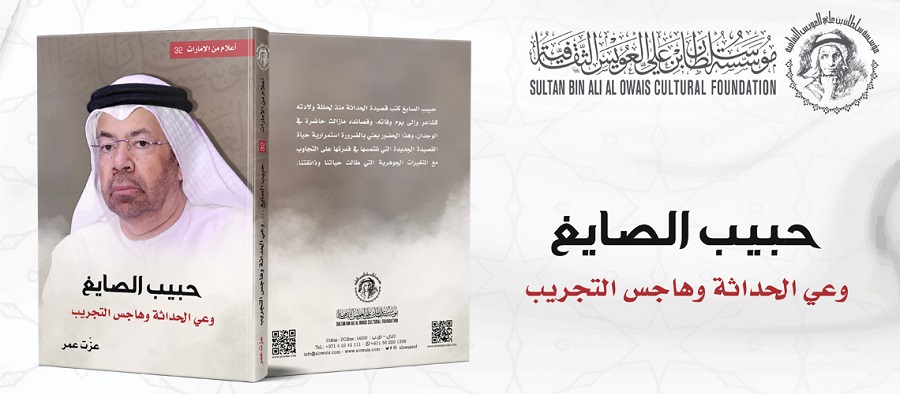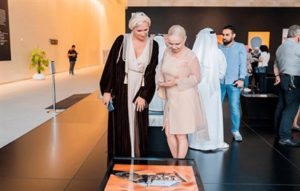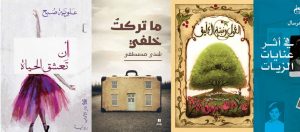The Sultan Bin Ali Al Owais Cultural Foundation has issued a new book -within its “Notable Figures from the UAE”book series- titled Habib Al Sayegh: The Modernist Awareness and the Obsession with Experimentation, by writer and critic Ezzat Omar. The first chapter of the book sheds light on the biography of late Emirati poet Habib Al Sayegh (1955-2019), also highlighting his upbringing in Abu Dhabi as well as his education and his budding genius. In addition to this, the author presents us with a general description of Al Sayegh’s poetry and his artistic approach in the same chapter, by touching upon press interviews with the late poet or through his weekly column in Al Khaleej Daily, simultaneously incorporating testimonials about Al Sayegh by a number of poets, critics and media personalities.
Moreover, the second chapter of the new publication, titled ‘The Book Poem’ reviews the stages of development of Al Sayegh’s poetry since the publication of his debut poetry collection ‘Huna Bar Bani Abs: Al Da’wa ‘Aama’ (Here is the Bar of Bani Abs Tribe, Open House, 1980), which is a paradoxical text that brings together two eras; the era of the tribe and the era during which the text was written in the late seventies. Al Sayegh was very much preoccupied with the issues and concerns of the Arab nation and inspired by Emirati heritage and Arab heritage in general. In his work, we see Captain Ahmed Bin Majid (known as ‘Lion of the Seas’) side by side with Antara as a reminder of the fight over the gulf.
Furthermore, author Ezzat Omar tackled Al Sayegh’s poetry collection “Mayari”, which is in the form of one poem dedicated to Arab women; celebrating their femininity through the symbolic woman ‘Mayari’. He also discusses another collection, “Usami Al Rada Waladi’ (I Call Death “My Son”), which is more of a speech in defiance of death that shows a great passion for life.
Meanwhile, the third chapter of the new book discusses other poetry collections by Al Sayegh, such as “Kasr fil Wazn” ((Broken Rhythm)), Wardat Al Kuhoola” (The Flower of Old Age) and Rasm Bayani Li Asrab Al Zarafat” (A Graph for Towers of Giraffes), meanwhile stopping at his prose poems and taf’ila poems and how they were connected to the era he lived in and the early modernist awareness manifested in his poetry and in the poetry of other Emirati poets. The book concludes by making a connection between the poetry of the late Al Sayegh and the heritage of the United Arab Emirates and the Arab world, as he is part of this important phase of Emirati culture in its journey towards Modernism and Post-Modernism. Al Sayegh’s creative legacy brings together mythology and heritage.
Speaking about his new book, author Ezzat Omar said: “For my research, I used a number of references about Al Sayegh’s poetry, which are comparatively few in number in comparison to the long poetic career of the late poet, which spanned over forty years. Perhaps the reason for this is that it is difficult to analyze the Modernist and Post-Modernist trends in his poetry, which is reflected in the surreal and fantastic elements. Hence, I hope I have given these aspects the attention and analysis they are due in my study.”
Habib Al Sayegh: The Modernist Awareness, comes in 200 medium-sized pages and is the 32nd book that is published within the “Notable Figures from the UAE” book series, which was launched by the Sultan Bin Ali Al Owais Cultural Foundation in 2012.
It is worth mentioning that the “Notable Figures from the UAE” book series underlines the role played by the Sultan Bin Ali Al Owais Cultural Foundation in supporting the local cultural scene and reflects its keenness on celebrating the pioneers who have paved the way in the fields of thought, culture and knowledge in the United Arab Emirates; dedicating their life to enlightenment and becoming torchbearers in the journey towards the future. Through this book series, the Foundation aims at documenting and shedding light on the lives and works of these unforgettable icons in the field of literature, art and thought who have left an indelible mark on public life and on the cultural and artistic scenes in order to keep them and their work alive in the minds of the public and so that the new generations benefit from their ambitious ideas that have transcended all the obstacles they witnessed to become a cherished legacy.




